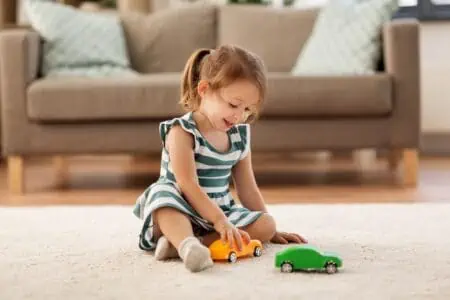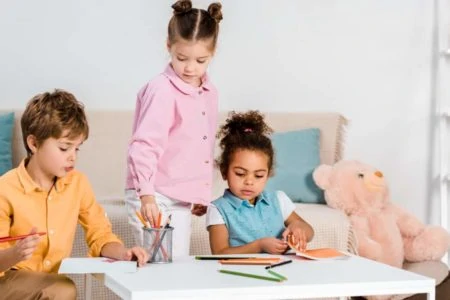Toddlers are wildly fantastic and chaotically wholesome creatures. But they sure can test a parent’s patience and capacity. As a toddler parent, it’s always helpful to learn more about their behavior to get tips and advice or simply see how your child compares to others.
We’ve compiled 40 fun toddler facts and statistics across five categories. In this post, you’ll learn about toddler development, language skills, the role of technology, and more.
Whether you have a one-year-old or a three-year-old, keep reading to understand more about this brilliant (but exhausting) stage of development.
5 Key Toddler Facts and Statistics
Did you know these amazing stats about toddlers?
Below are five of the most interesting facts about them. If you’re looking for more in-depth information, we have 40 more facts to share.
- Between 12 and 36 months, toddlers learn to stand, walk, jump, and even ride a tricycle.
- By 24 months, most children can say two words together.
- The blue light from screen time can interfere with a toddler’s healthy sleeping pattern.
- The average age for potty training in the United States is between two and three years.
- Almost 66 percent of toddlers were in early education in 2017.
Toddler Milestone Checklist
As a parent, it’s important to monitor our child’s development to ensure they are progressing. But remember that every child develops at a different pace, and it’s okay if your child is slightly behind or ahead.
If you have concerns about your toddler reaching their milestones, check in with their health provider. That being said, here is a toddler milestone checklist based on years of psychology and medical research:
12 to 18 Months
- Takes first steps.
- Says three to five words.
- Makes non-verbal gestures, such as waving.
- Searches for hidden objects.
- Plays social games, like Peekaboo.
- Calls parents by given names, like mama or dada.
- Understands the word ‘no’.
- Can put objects in a container.
- Can drink from a cup without a lid (with assistance).
- Has a developed pincer grip.
- Stacks objects.
- Has a sleep pattern.
- Eats various foods.
- Follows simple directions.
- Can identify one or two body parts.
- Understands up to 50 words.
18 to 24 Months
- Tries saying new words.
- Understands pronouns such as me, you, or my.
- Understands new words.
- Can identify five body parts.
- Strings two words together.
- Follows two-step directions, such as ‘Get your shoes and bring them to me’.
- Likes listening to stories.
- Walks independently.
- Uses cutlery.
- Points to show you something.
- Helps with getting dressed.
- Copies you doing chores.
- Plays with toys as they are intended.
- Climbs on and off a chair or couch.
- Can run.
- May have tantrums.
- Might be afraid of new people.
- Shows affection with familiar people.
- Shakes head ‘no’.
- Shows interest in stuffed animals and dolls.
24 to 30 Months
- Notices when people are upset.
- Watches your facial reactions.
- Points at things when you ask questions, like ‘Where are your shoes?’
- Strings two to four words together.
- Copies others.
- Uses gestures like blowing a kiss.
- Tries to use buttons, knobs, and switches.
- Plays with more than one toy at a time.
- Shows more independence.
- Kicks a ball.
- Understands at least half of your speech.
- Runs.
- Walks up and down stairs without help (but supervised).
- Points to things or pictures when they are named.
- Knows names of familiar people.
- Starting to sort shapes and colors.
- Builds towers with four or more blocks.
- Stands on tiptoe.
- Uses words like ‘in’ and ‘on’.
- Turns pages in a book.
- Knows own name.
30 to 36 Months
- Sometimes plays with other children.
- Says, ‘Look at me’.
- Follows simple routine instructions.
- Says about 50 words.
- Strings two to four words together.
- Playing pretend.
- Climbs well.
- Runs well.
- Pedals a tricycle.
- Shows affection without prompting.
- Has problem-solving skills.
- Can do puzzles with three or four pieces.
- Builds towers with more than six blocks.
- Knows at least one color.
- Can turn doorknobs or unscrew lids.
- Takes some clothes off by themselves.
- Jumps with both feet.
- Is concerned about their friends being upset.
- Isn’t too upset to separate from parents.
- Notices changes in routine.
- Grips a pen or crayon with fingers (instead of fists).
- Names most familiar things.
- Says first name, age, and sex.
- Says pronouns like I, me, we, and you.
- Talks well enough for strangers to understand most of the time.
- Asks ‘what’, ‘why’, and ‘where’.
- Uses plural nouns.
- Understands simple sentences.
- May be toilet trained or training.
Three to Four Years
- Calms down soon after being left somewhere (like daycare).
- Wants to play with other kids.
- Has back-and-forth conversations with you.
- Asks ‘who’, ‘what’, ‘where’, and ‘why’ questions.
- Can name actions in a picture book.
- Hops on one foot for up to five seconds.
- Can go up and down stairs independently.
- Throws a ball overhead.
- Can say their own first name when asked.
- Talks well enough for strangers to understand.
- Can draw a circle and square.
- Can use child-friendly scissors.
- Uses three-word sentences at least.
- Tells stories.
- Knows some color names.
- Understands time better.
- Plays pretend.
- Negotiates solutions to a problem.
- Knows not to touch dangerous objects, like hot stoves.
- Can string items, like beads, together.
- Can put on some clothes independently.
40 Fun Facts About Your Toddler
The definition of a toddler is a person who toddles, typically those between one and three years of age. If you’ve ever met one, though, you’ll know there is so much more to them than that. These wildly funny and interesting beings are full of energy, delight, and wonder. Below are 40 interesting facts about preschoolers.
Development Stages and Milestones
Let’s look at eight amazing facts about toddlers’ physical, cognitive, and emotional development during their toddler years. While newborns and infants change so much in that first year, toddlerhood is a new kind of magic to witness.
- Gross motor skills: The gross motor skills a toddler develops from 12 to 36 months include standing alone, walking, walking backward, jumping, and riding a tricycle (1).
- Fine motor skills: Toddlers also learn to use small muscles in their hands and fingers. Between 15 and 18 months, they begin to scribble. By 24 months, they should be able to stack up to four items, use a spoon, and try copying a circle.
- Cognitive developments in two-year-olds: Around 24 months, toddlers should be developing their learning, thinking, and problem-solving skills in a wonderful way. They should be able to find things, even when hidden under a few layers, sort shapes and colors, play pretend, and follow two-step instructions.
- Cognitive development warning signs: If your toddler does not copy others, point to show you things, does not follow simple instructions, or loses skills they already had, then talk to your health care provider (2).
- Emotional development in one to two-year-olds: During your child’s second year of life, you may notice more emotions, including happiness and intense rage (3). It’s important to talk to them about their feelings and show them an appropriate response, even if they don’t quite understand yet.
- Emotional developments in two to three-year-olds: During the infamous terrible twos, your child will show more independence. This can lead to more tantrums when they don’t get their way. It’s possible to prevent tantrums by giving your child more choices in order to help them feel valued and practice making decisions. When it’s bedtime, giving them two choices of pajamas or asking them to choose two books can make a huge difference.
- Language and communication: In two-year-olds, important language milestones include saying short sentences (between two and four words) and pointing to things you name (4). They should also know familiar body parts and recognize familiar faces.
- Food milestones: While feeding a toddler is never easy (they can be fussy), your toddler should be able to use a spoon and fork and chew with full jaw movements.
Language Skills and Social Development
Toddlers typically develop their language skills rapidly, but everyone develops at a different pace. Below are eight interesting facts about a toddler’s language and social development. Keep in mind this is for the toddler age group rather than 4-year-olds and 5-year-olds.
- Vocabulary and language development from 12 to 24 months: Between one and two years, toddlers will learn and understand a wider variety of words (5). Typically, they start with nouns, followed by verbs, then adjectives.
- Learning common words: From 12 months, toddlers will understand or state words associated with things they see most often. For example, my son’s first words included ‘duck’ (his favorite bath toy) and ‘book’ (since we’re always reading).
- Language from 15 to 18 months: Around 15 months, your child may point to things, encouraging you to name things. By 18 months, your child may learn their name and use it to refer to themselves in the third person (so cute).
- Vocabulary and language development from two to three years: During this time, toddlers learn a whole bunch of new words (6). Mostly, they will be nouns, but you’ll also get verbs (like ‘play’ or ‘run’), adjectives, pronouns (like ‘you’ and ‘me’), and location words (like ‘in’ or ‘under’).
- Sentences and grammar: Most two-year-olds will start to string words together to make a two or three-word phrase, such as ‘blue jacket’ or ‘I need nap’. By three, they might be able to use sentences with three words or more.
- Amount of words: By 24 months, most children can say at least two words together (7). By 30 months, they might have a vocabulary of about 50 words. By 36 months, toddlers usually have a vocabulary consisting of 200 words or more.
- Language red flags: If, by three years old, your child cannot say 50 words, name familiar objects, describe an action they see in a picture, or say their first name, you should let your doctor know. They may want to refer you to a speech therapist or check your child’s hearing.
- Pronunciation: By the age of three, toddlers can mimic most speech sounds, but they might still struggle with some sounds, such as ‘v’, ‘ch’, and ‘th’.
Screen Time and Technology
In parenting, we all know there is a time and place for screen time. When you’re exhausted from being up all night or need to work from home, putting on a movie can be a great distraction. However, it’s important to note both the pros and cons of screen time. Below are eight facts about how screen time affects a toddler’s well-being.
- Content risk: Children who watch content unsupervised may be exposed to sexual content, themes of substance abuse, wrong information, and advertisements (8). Parents should try to watch content before their children to ensure they are happy with the themes.
- Screen time affects sleep: Toddler isn’t sleeping well? Screen time may be to blame. The blue light emitted by screens can disrupt a child’s sleep by interfering with their sleep-wake cycle (9). Blue light also suppresses melatonin, the hormone that lets us know we’re feeling sleepy. Evening screen time exposure can suppress melatonin in children twice as much as adults, leading to later bedtimes and less overall sleep.
- Screen time and obesity: The more screen time your child gets, the more likely they are to be overweight (10). The risk of obesity also increases when a child has electronics in their bedrooms.
- Behavior issues from technology: Kids with access to two or more hours of screen time per day are more likely to display behavioral issues, such as social or attention problems.
- Avoiding screen time for toddlers under 18 months: The American Academy of Pediatrics (AAP) recommends avoiding screen time for toddlers under 18 months (11). After this, they recommend parents choose ‘high-quality’ programming, limiting it to one hour per day between 18 months and five. They also recommend parents watch the programs with their children. High-quality programs include PBS Kids, Sesame Workshop, Common Sense Media, and other programs that improve literacy and cognitive skills.
- Screen time and body learning: Toddlers need to be entertained in a way that helps them develop their gross and fine motor skills. Screen Time typically involves being sedentary, which limits a toddler’s opportunity to explore how to use their body.
- More screen time equals less reading: Toddlers who regularly had access to screens were less likely to enjoy reading with their parents at the age of three (12). This led to increased screen time by the age of five. Screen time for five-year-olds increased by 25 minutes per week for every 10-minute decrease in daily reading time at three.
- Emotional reactivity and screen time: A study found that increased screen time between six and 18 months was linked with emotional reactivity and aggression (13).
Toilet Training Facts
Toilet training can be very daunting for parents. It’s another huge milestone in their development, and it can often feel like you’re regressing to the chaotic newborn days. Below are eight interesting facts about toilet training.
- Average age in the United States: In the U.S., the average age for toilet training is between two and three years (14).
- Before 27 months: Some studies suggest toilet training is not beneficial before 27 months (15). In fact, children who start earlier take longer to complete training. On average, toddlers who started toilet training between 18 and 24 months took 13 to 14 months to finish toilet training. Toddlers who started after 27 months only took 10 months to finish toilet training.
- After 32 months: Although starting earlier may have drawbacks, so does starting late. Research suggests that toddlers trained after 32 months might find toilet training more challenging, leading to more accidents.
- Toilet training sweet spot: The toilet-training sweet spot for most kids is between 27 and 32 months (16). But every kid is different, so don’t feel pressured by this statistic.
- Toilet training by race: White parents typically began toilet training later than Black parents, starting at 25.4 months versus 19.4 months. Parents of other races also began at 19.4 months.
- Toilet training readiness: Children are typically ready for toilet training if their diapers are dry for two hours at a time or they’re dry after a nap. Other signs include indicating they are about to poop or pee; following simple instructions; can walk to the bathroom; ask for a diaper change; ask to wear underwear.
- Potty training too soon: Some people try to potty train too early, but it’s important to remember that toddlers can’t hold their pee and poo in until they’re at least 12 to 18 months of age.
- Toilet training methods: There are a few popular toilet training methods in the U.S., including the Brazelton approach, Dr. Spock’s training method, and the Azrin and Foxx ‘training in a day’ method.
Early Education and Child Care
In many countries, early education is not necessarily the norm. But in the U.S., most parents don’t get extended parental leave, meaning their children typically go into childcare much earlier, such as daycare. Let’s look at the effects that early education has on toddlers.
- Number of children in early education: In the U.S., almost 66 percent of preschool-aged children (i.e., toddlers) are in early education (17). Seven million three to five-year-olds had early education in 2017. In comparison, only 37 percent of children had early education in 1970.
- Public versus private education: From 1970 to 2017, the number of children in public programs went from 26 percent to 46 percent. Those attend ing private programs increased from 12 to 18 percent.
- Full-day versus part-day: More children attend full-day childcare now than in 1970. Sixty-five percent of toddlers attend full-day childcare, compared to 17 percent in 1970.
- Early education during the pandemic: Between 2019 and 2021, the number of three to six-year-olds enrolled in preschool dropped to 41.8 percent from 51.1 percent (18).
- Preschool’s impact on college: Toddlers who access early education by age four are more likely to attend college (19). They are also more likely to be a high school graduate and have taken the SAT.
- No effect on standardized tests: There is no known correlation between kids who attended preschool and getting better grades on standardized testing.
- Childcare options: The most common childcare options are daycare centers, preschool, prekindergarten, relative care, or nonrelative care (such as a nanny) (20). Of those with childcare, the majority (62 percent) went to center-based care in 2019, while 38 percent were looked after by a relative.
- Positive impact of center-based care: Kids who attended daycare, as opposed to staying with parents, family, or even a nanny, from six months old, had better cognitive and language skills by three (21). They also had better academic skills by 4.5 years and fewer behavioral issues at ages two and three compared to children without center-based care. However, by 4.5 years of age, children who attended center-based care sometimes showed more behavioral challenges.









